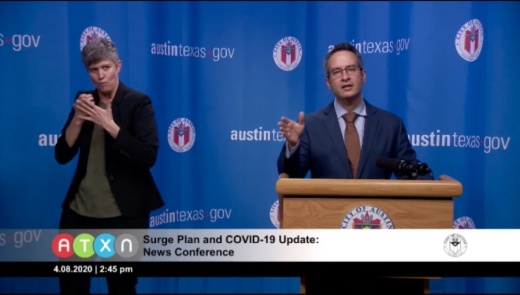Local government and public health officials said the community needs to continue working to lower the number of social interactions to buy time for personal protective equipment to arrive for hospital workers, facilities for patients who need a low level of care to open, and testing to improve.
Researchers from The University of Texas released new models on April 8 incorporating recent data on hospitalizations after social distancing measures were already put in place. Local government officials are putting together plans for the five-county Central Texas region based on a 50% reduction in contact amongst local residents. With that 50% reduction, according to the model, the metro area could expect 1.7 million cases of the coronavirus, more than 80,000 hospitalizations and more than 9,000 deaths between March 1 and Aug. 17.
The peak of cases, according to that 50% reduction model, would come in late May and into early June.
“While we read in the newspapers about this being the ‘Pearl Harbor’ week, that may be true for New York, but it is not true for here,” Mayor Steve Adler said at an April 8 press conference.
Central Texas residents appear to be outperforming that 50% reduction in physical contact. While data shows a 64% reduction, that number may not tell the whole story because, Adler said, hospitalization data now reflects actions taken by the community weeks ago due to the time the virus takes to present symptoms in those who have been infected.
While Williamson County officials said there is no perfect measure for the rate of an individual’s personal social distancing habits, a tool called Cubiq can use GPS cell phone data to measure the median distance traveled by those devices. That data shows a 59.6% reduction in travel in Travis County from March 18—after schools and dine-in service at restaurants were already closed—to April 8 and a 43.5% reduction in Williamson County in the same time frame.
Eckhardt said the five-county “surge plan” being developed includes identifying and procuring personal protective equipment for medical workers and ensuring health care facilities are adequately staffed to handle the volume of patients.
"Let’s stay the course. We are saving lives. The life you save may not be anybody you know—but it’s far better to overprepare and be able to hug that person sometime in the future than the alternative,” Eckhardt said.
The plan also will include emergency backup medical facilities in case hospitals are overwhelmed. Dr. Mark Escott, the Austin Public Health interim health authority, said emergency backup medical facilities are being identified in case the 4,300 hospital beds currently available are not enough.
Escott said once the locations of those emergency facilities are finalized, they will be shared with the public. They could include outpatient surgical centers or former hospitals, and seven potential sites have been identified so far. Currently, Escott said, hospitals are at about 50% capacity.
As local governments continue to anticipate an increase in cases and lean toward being overprepared as opposed to the alternative, Escott and Adler said the community’s continued social distancing effort is important to taking care of the public’s health.
“The longer we can push off the peak, the better we’ll be able to care for people,” Escott said.





